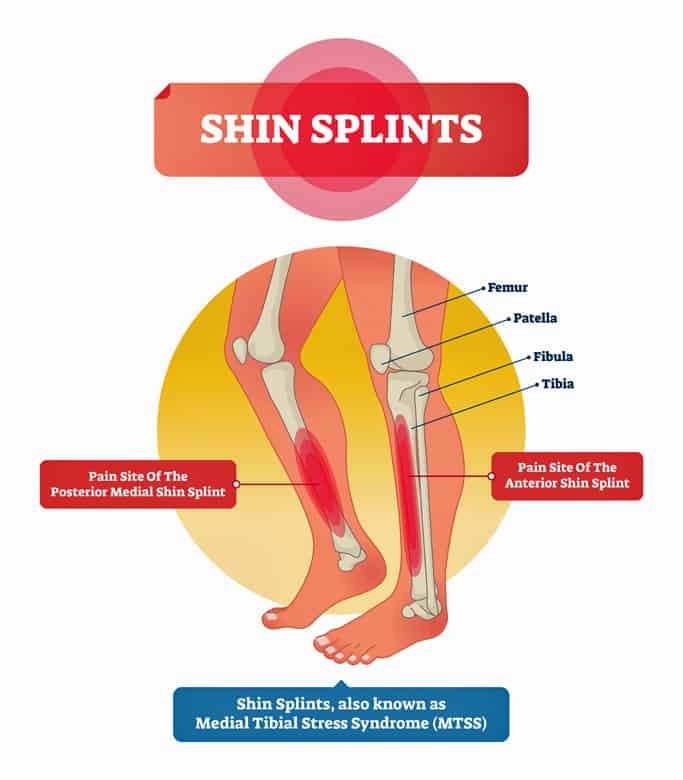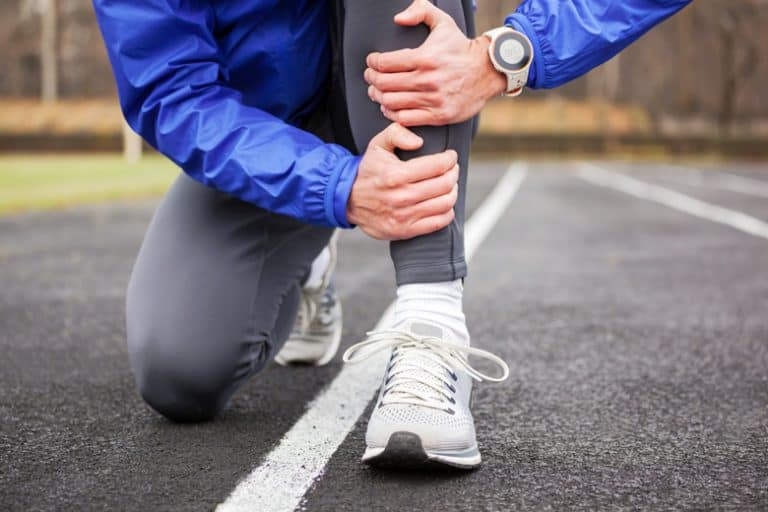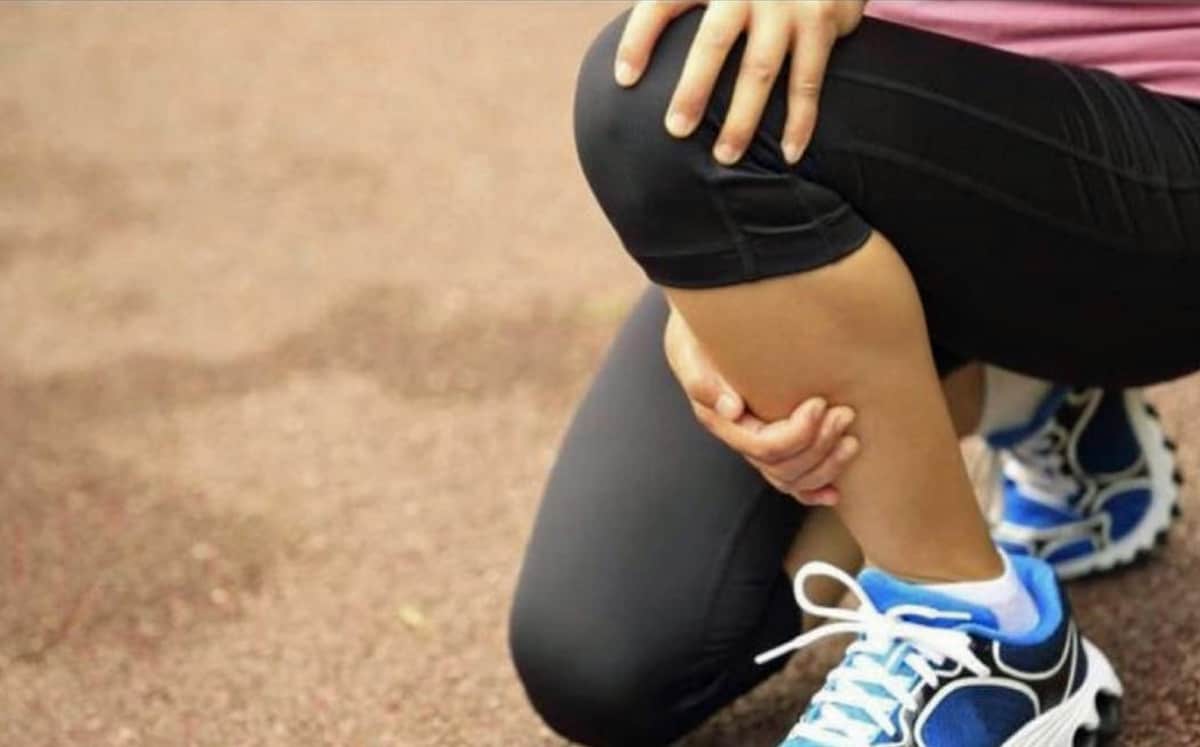If you’ve ever had shin splints then you know that 1, they suck! 2, they can be incredibly painful and 3, they can be a huge detriment to your training and sporting goals.
I know first hand how frustrating it can be as I suffered from severe shin splints myself. A combination of athletics and basketball beat my shins up pretty bad and I was unable to compete in either sport for a long time.
But don’t worry, you don’t need to suffer the same fate. Shin splints can be managed and even avoided altogether. Keep reading and use these tips to keep yourself in action!
Note: If you have any severe or chronic pains you should seek professional medical assistance!
15 Ways To Prevent And Treat Shin Splints
- Stretch your Achilles tendons and calf muscles.
- Take enough rest and switch activity.
- Don’t always train in spikes.
- Switch up your training surfaces.
- Run with Proper sprinting mechanics.
- Change your running shoes.
- Massage the painful area with ice.
- Add arch support to your shoes.
- Change your running direction.
- Add compression support or tape.
- Check for muscular imbalances.
- Check for biomechanical irregularities.
- Use a foam roller.
- Strengthen the muscles.
- Head to the sandpit.
What Are Shin Splints?
As the name suggests, shin splints occur in the shins along the shin bone (tibia) and muscle (the anterior tibialis).
The medial area is the most common site for shin splints but they can also occur towards the outside of the leg.

Shin splints can be explained as the muscle tearing from the bone, inflammation of the shin muscle or a combination of the two.
In bad cases, the muscle is slightly torn along the bone and can continue to do so if the problem becomes severe.
Under high and continuous exposure to stress, shin splints can result in more serious conditions such as a stress fracture or broken leg.
So definitely not something to ignore!
Issue For Sprinters
Shin splints can be described as an overuse injury. This basically means that the injury is caused when you put a muscle under continuous stress repetitively.
Unfortunately, this makes sprinters extremely susceptible to shin splints.
Here’s why…
While sprinting, it’s important to keep the foot dorsiflexed during the forward phase of the stride cycle.
This will help you generate large forces upon ground contact which will help you generate speed.
The shin muscle controls these movements. Therefore it is the muscle that absorbs the largest amount of force while you are sprinting. This repetitive motion can take its toll on your shins.
What Should I Do If I have Shin Splints?
First, you need to evaluate the cause of the pain to establish whether you have shin splints or not. You don’t need to become an anatomy expert, but it does help if you know where the pain is coming from so that you can start an effective treatment.
Don’t assume that because you have pain in the shin that it must be shin splints. Other types of shin pain or lower leg pain can include anterior pain along the outside of the leg and stress fractures.

Discomfort from shin splints is often described as sharp pain and is usually more generalised to one spot rather than pain along the entire shin.
Try to apply some pressure through the fingertips along the shin muscle and you should be able to feel which spot the pain is coming from.
When you feel pain in your shins, you should decrease your workload or stop training completely depending on your level of pain.
If in doubt, stop!
If you are unsure and the problem persists then you should always check with your physio or a medical professional.
But if you are here then I guess you came for the tips on preventing or recovering from shin splints.
Here they are…
15 Tips To Prevent And Combat Shin Splints
1) Stretch Your Achilles Tendons And Calf Muscles
Tightness around your Achilles tendons and calf muscles can contribute to shin splints. Spend time stretching every day or every other day depending on the tightness of the muscles.
Inadequate stretching can lead to many injuries but can also be directly related to your shin problems. Spend a good amount of time stretching with various static and dynamic stretches.
2) Take Enough Rest And Switch Activity
Shin splints are an overuse injury. It makes sense that your first step should be to rest.
Even after you feel okay, shin splints have a nasty way of creeping back up on you so I suggest switching up your activity.
Try cycling or getting in a pool. Swimming and even pool running are great ways to help recovery whilst still remaining active.
3) Don’t Always Train In Spikes
If you train many times a week using spikes then you are putting your shins and calves under a lot of pressure.
Spikes are not built to provide the foot with a lot of support. Therefore constant use every session can lead to chronic injuries such as shin splints.
Spikes should only be worn during sets performed at or close to competition speed. Work performed below this intensity should be performed in trainers or even barefoot.
4) Switch Up Your Training Surfaces
Be aware of the type of surface you are training on. Hard tracks are great for running fast times in competition but they can be awful on the shins and joints when training day in day out.
Try training on grass. The grass is great for repetitive exercises such as drills, bounding and other plyometric exercises.
If you feel pain in the shins, then I recommend not training on the track until the pain is gone entirely. The impact of the grass will be much less stressful.
Avoid sprinting on concrete entirely. The hard surface can cause havoc with your anterior tibialis as the impact absorbed from the ankle to knee travels through it.
5) Proper Sprinting Mechanics
Proper sprinting mechanics can help prevent shin splints. In general, athletes often hit the ground too hard. Their foot-to-ground contact time is too long and/or they hit the ground with the wrong part of the foot.
which makes a very distinct sound.
While sprinting on a track, if there is a ‘thud’ with every foot strike, then you are hitting the ground too hard. Doing this repeatedly is sure to lead to shin splints or another kind of injury. Your spikes should scrape the surface of the track as you want your leg cycle to be as rapid as possible.
6) Change Your Running Shoes
When was the last time you changed your running shoes? It may sound obvious but often athletes don’t think about this.
If you’re running in worn down shoes that provide you with minimum support then you are asking for a whole heap of lower leg issues.
I suggest having two pairs of trainers/spikes, one for training and one for competition.
7) Massage The Pain Area With Ice
Massaging the muscle with ice is the best way to reduce swelling and inflammation. Don’t just hold the ice pack against your shin. You want to apply a bit of pressure and massage along the shin muscle for around 15 minutes.
If you’re experiencing shin trouble then use ice after every hard training day or after a competition. Continue this even as the pain subsides just as a preventative measure.
Tip: Ice packs are usually not suited for this. Try filling a small bag with ice cubes or freezing water in a cup. This works great.
8) Add An Arch Support To Your Shoes
Firstly, check the arch of your foot.
If you are flat footed then you are also naturally placing more stress on your lower legs. This could be the cause of many problems. Lifting the arch with support or insoles can really help relieve stress and help reduce pain.
Spend time building up strength in your lower legs. Not just the shins, but the feet, ankles etc. and you should eventually be able to remove the support.
9) Change Your Running Direction
Make sure you run in both directions during training.
Example. If a 400m sprinter always runs the bends in the same direction, they are putting one leg and one side of their hip under much more pressure than the other.
This can lead to muscle imbalances and make one side more susceptible to injury.
10) Add Compression Support Or Tape
You can try wrapping your leg up before training. Go from above the ankle right up until you reach the bottom of your knee so that the entire shin is completely covered.
You can continue doing this until you no longer feel pain. This helps prevent the amount of pressure placed on the shins.
11) Check For Muscular Imbalances
Are your calf muscles way stronger than your shin muscles? Do you have one leg stronger than the other?
These things are important to consider and you should spend time making sure you don’t have any muscular imbalances.
This is often the case when you have shin splints in one leg. To eliminate muscular imbalances of the lower leg, try running with a shorter stride.
You can also perform exercises to strengthen the shin muscles. As you increase your strength you can gradually begin to open up your stride length.
This will take the pressure off the shins and allow you to continue running without discomfort or pain while strengthening at the same time.
12) Check For Biomechanical Irregularities
Sometimes an athlete will just have a biomechanical irregularity. In this case, you need to do two things.
First is to work out if there is a way to alleviate the stress that induces shin splints or eliminate it entirely. This may be as simple as raising the arch of the foot using shoe insoles. Or you may need to see a specialist to solve the issue.
The second is whether training at your current intensity level is going to be harmful to you in the long run.
This is sometimes difficult to accept but the harsh truth is that sometimes our bodies betray us and are just not suited for the task we want them to do.
If you can’t solve the irregularity, no amount of pain relief, icing, stretching etc. can combat continuous damage over a long period of time.
13) Use A Foam Roller
Foam rollers are a great way to alleviate any tightness within the shins. This can help increase blood flow and decrease any muscle soreness.
I suggest using a foam roller or massage ball. If you don’t have these pieces of equipment then try using a tennis ball or applying pressure with your thumb to massage the area.
14) Strengthen The Muscles
Focus on strengthening the muscles of the lower leg. You want to strengthen your tibialis anterior muscle primarily as this is the pain area but also look to strengthen the muscles of the calf as well.
Do light exercises with bodyweight or therabands for light resistance. As the muscles get stronger, you can increase the resistance.
15) Head To The Sandpit
Performing various drills and plyometric exercises in the sandpit is a great way to strengthen your ankles and shins.
The great thing about this type of training is that it is low impact. The sand provides an increased resistance that increases the workload that the muscles are used to.
The instability of the sand strengthens the muscles that stabilise the joints of the ankles, knees and hips.
Added benefits of this type of training include a greater range of motion and improved balance.
So there you have it… 15 tips on how to alleviate or prevent shin splints that you can begin to apply right away.

